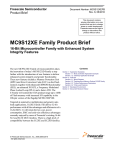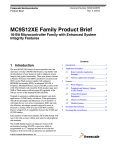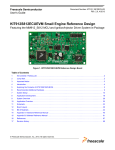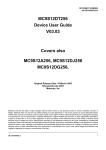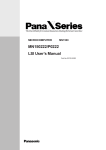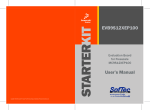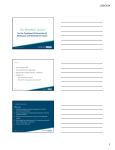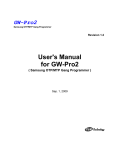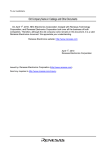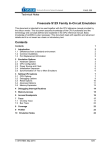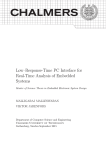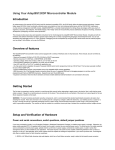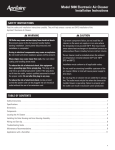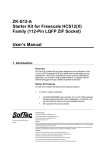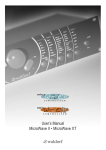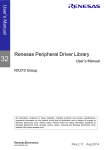Download MC9S12XE Family Product Brief
Transcript
Freescale Semiconductor Product Brief Document Number: MC9S12XEPB Rev. 7, 05/2008 This document contains preview information on a new product that may be in a design phase or under development. Freescale reserves the right to change or discontinue this product without notice. MC9S12XE Family Product Brief 16-Bit Microcontroller Family with Enhanced System Integrity Features The new MC9S12XE Family of microcontrollers takes the innovation of today’s MC9S12XD Family a step further with the introduction of new features to deliver enhanced system integrity and greater functionality. These new features include a Memory Protection Unit (MPU) and Error Correction Code (ECC) on the Flash memory together with enhanced EEPROM functionality (EEE), an enhanced XGATE, a Frequency Modulated Phase Locked Loop (IPLL) and a faster ATD. The E Family will extend the S12X product range up to 1MB of Flash memory with increased I/O capability in the 208-pin version of the flagship MC9S12XEP100. Targeted at automotive multiplexing and generic auto body applications, S12XE Family will deliver 32-bit performance with all the advantages and efficiencies of a 16-bit MCU. It will retain the low cost, power consumption, EMC and code-size efficiency advantages currently enjoyed by users of Freescale’s existing 16-bit S12 and S12X MCU families. There is a high level of compatibility between the S12XE and S12XD families. © Freescale Semiconductor, Inc., 2008. All rights reserved. Contents 1 2 3 4 Application Examples . . . . . . . . . . . . . . . . . . . . . . . . . . . . 2 1.1 Body Controller Application Example . . . . . . . . . . . 2 1.2 Gateway Application Example. . . . . . . . . . . . . . . . . 3 Features . . . . . . . . . . . . . . . . . . . . . . . . . . . . . . . . . . . . . . 4 2.1 Block Diagram . . . . . . . . . . . . . . . . . . . . . . . . . . . . . 4 2.2 Peripheral and Memory Options S12XE Family . . . 5 2.3 Critical Performance Parameters . . . . . . . . . . . . . . 6 2.4 Chip-Level Features . . . . . . . . . . . . . . . . . . . . . . . . 6 2.5 Module Features . . . . . . . . . . . . . . . . . . . . . . . . . . . 7 Developer Environment. . . . . . . . . . . . . . . . . . . . . . . . . . 12 Document Revision History. . . . . . . . . . . . . . . . . . . . . . . 14 Application Examples Like members of other S12X families, the S12XE Family will run 16-bit wide accesses without wait states for all peripherals and memories. The S12XE Family features an enhanced version of the performance-boosting XGATE co-processor which is programmable in “C” language and runs at twice the bus frequency of the S12X with an instruction set optimized for data movement, logic and bit manipulation instructions and which can service any peripheral module on the device. The new enhanced version has improved interrupt handling capability and is fully compatible with existing XGATE module. As with the S12XD Family, the S12XE Family features an enhanced MSCAN module which, when used in conjunction with XGATE, delivers FULL CAN performance with virtually unlimited number of mailboxes and retains backwards compatibility with the MSCAN module featured on existing S12 products. The S12XE Family has full 16-bit data paths throughout. The non-multiplexed expanded bus interface available on the 144-pin versions allows an easy interface to external memories. In addition to the I/O ports available in each module, up to 25 further I/O ports are available with interrupt capability allowing wake-up from STOP or WAIT mode. The S12XE Family is available in 208-Pin MAPBGA, 144-pin LQFP (both with optional external bus), 112-pin LQFP or 80-Pin QFP options. 1 Application Examples The following sections describe target applications of the MC9S12XE. 1.1 Body Controller Application Example In this example, the MC9S12XE is implementing the features of a typical car body controller application. The module interfaces with the main CAN buses distributed in the car using the on-chip MSCAN module whereas the LIN bus communicates with functions local to the body controller. In both cases the communication functions are managed by the XGATE independently of the CPU. The MC9S12XE provides direct control of power drivers for lights and pumps and reading of sensors, using the on-chip PWM and ATD modules. Finally, the SPI interface to the RF receiver provides the interface to the car remote access system. MC9S12XE Family Product Brief, Rev. 7 2 Freescale Semiconductor Application Examples RF Receiver Smart Power Smart Power Switches Smart Power Switches Smart Power Switches (lighting…) SPI SPI Digital Inputs (including Input Capture signals) LS CAN Body CAN P/I S12XE CAN P/I XGATE CAN P/I EEPROM Switch panel and digital sensors Digital Outputs (PWM or not) HS CAN Powertrain Analog Inputs HS CAN Diagnostic SCI Direct loads (power latch, pumps, locking…) Diagnostic Battery monitoring, and misc. sensors SCI Power seat LIN P/I Door modules LIN P/I LIN Steering column Rain sensor & sunroof control LIN Figure 1. Body Controller Application Example 1.2 Gateway Application Example In this application, the MC9S12XE provides gateway functionality between its on-chip CAN and LIN modules. Much of the low-level communications functionality is handled by the XGATE, which frees the CPU to manage higher level communications and other direct connections to the module. LS CAN Body Digital Inputs CAN P/I HS CAN Telematics S12XE CAN P/I Switch panel Digital Outputs (PWM or not) Direct loads HS/LS CAN Chassis CAN P/I SCI XGATE HS CAN Powertrain LIN Door modules right side LIN P/I CAN P/I EEPROM HS CAN Diagnostic SCI SCI Door modules left side SCI Wiping Front lighting LIN P/I LIN P/I Steering column Switch panels LIN LIN P/I CAN P/I Power seats LIN LIN Rain sensor & sunroof control Figure 2. Gateway Application Example MC9S12XE Family Product Brief, Rev. 7 Freescale Semiconductor 3 Features 2 Features Features of the S12XE Family are described in this section. 2.1 Block Diagram PLL with Frequency Modulation option Reset Generation and Test Entry EWAIT PA[7:0] PTA ADDR[15:8] PB[7:0] PTB ADDR[7:0] PC[7:0] PTC ADDR[22:16] DATA[15:8] PD[7:0] DATA[7:0] PTF CS0 CS1 CS2 CS3 SDA SCL RXD TXD PF0 PF1 PF2 PF3 PF4 PF5 PF6 PF7 8ch 16-bit Timer Enhanced Multilevel Interrupt Module MPU XIRQ IRQ RW/WE LSTRB/LDS ECLK MODA/TAGLO/RE MODB/TAGHI XCLKS/ECLKX2 PTD PK[7:0] PTK Memory Protection 8 regions XGATE PE0 PE1 PE2 PE3 PE4 PE5 PE6 PE7 PTE TEST PWM PIT Non-Multiplexed External Bus Interface RESET Clock Monitor COP Watchdog Periodic Interrupt Async. Periodic Int. IIC0 Inter IC Module SCI3 Asynchronous Serial IF PWM[7:0] 8-bit 8 channel Pulse Width Modulator RXD SCI0 TXD Asynchronous Serial IF RXD SCI1 TXD Asynchronous Serial IF SPI0 MISO Synchronous Serial IF CAN0 msCAN 2.0B CAN1 msCAN 2.0B CAN2 msCAN 2.0B CAN3 msCAN 2.0B SCI4 Asynchronous Serial IF SCI5 Asynchronous Serial IF SCI6 Asynchronous Serial IF SCI7 Asynchronous Serial IF SCI2 Asynchronous Serial IF MOSI SCK SS MISO MOSI SCK SS MISO MOSI SCK SS RXCAN TXCAN RXCAN TXCAN RXCAN TXCAN RXCAN TXCAN RXD TXD RXD TXD RXD TXD RXD TXD RXD TXD IIC1 Inter IC Module CAN4 msCAN 2.0B SDA SCL RXCAN TXCAN Synchronous Serial IF SPI1 Synchronous Serial IF SPI2 PTAD0 XTAL Amplitude Controlled Low Power Pierce or Full drive Pierce Oscillator IOC[7:0] PTAD1 EXTAL 16-bit 8 channel Timer X BKGD Debug Module Single-wire Background 4 address breakpoints Debug Module 2 data breakpoints 512 Byte Trace Buffer PTT CPU12X PT[7:0] PTR IOC[7:0] 16-bit 8 channel Enhanced Capture Timer TIM PR[7:0] PP[7:0] PTS Voltage Regulator PAD[31:16] PTH (Wake-up Int) 8/10/12-bit 16-channel AN[15:0] Analog-Digital Converter ECT PTM 2K … 4K bytes EEPROM VDDR VDD1 VDDF VDDPLL PAD[15:0] PTL 8/10/12-bit 16-channel AN[15:0] Analog-Digital Converter ATD1 12K … 64K bytes RAM PTJ (Wake-up Int.) ATD0 128K … 1M bytes Flash PTP (Int) Figure 3 shows a top-level block diagram of the S12XE Family. PS0 PS1 PS2 PS3 PS4 PS5 PS6 PS7 PH0 PH1 PH2 PH3 PH4 PH5 PH6 PH7 PM0 PM1 PM2 PM3 PM4 PM5 PM6 PM7 PL0 PL1 PL2 PL3 PL4 PL5 PL6 PL7 PJ0 PJ1 PJ2 PJ3 PJ4 PJ5 PJ6 PJ7 Figure 3. MC9S12XE Block Diagram MC9S12XE Family Product Brief, Rev. 7 4 Freescale Semiconductor Features 2.2 Peripheral and Memory Options S12XE Family Table 1. Peripheral and Memory Options of S12XE Family Members Device Package 208 MAPBGA 9S12XEP100 9S12XEP768 9S12XEQ512 9S12XEQ384 9S12XET256 9S12XEG128 XGATE CAN1 SCI2 SPI3 IIC4 yes 5 8 3 2 ECT TIM PIT A/D5 I/O6,7 Flash RAM 8ch 8ch 8ch 2/32 152 8 144LQFP 5 8 3 2 8ch 8ch 8ch 2/24 119 112LQFP 5 8 3 1 8ch 0 8ch 2/16 91 208 MAPBGA 5 8 3 2 8ch 8ch 8ch 2/32 152 144LQFP 5 8 3 2 8ch 8ch8 8ch 2/24 119 112LQFP 5 8 3 1 8ch 0 8ch 2/16 91 144LQFP 4 6 3 2 8ch 0 4ch 2/24 119 112LQFP 4 6 3 1 8ch 0 4ch 1/16 91 80QFP 4 2 3 1 8ch 0 4ch 1/8 59 144LQFP 4 6 3 2 8ch 0 4ch 2/24 119 112LQFP 4 6 3 1 8ch 0 4ch 2/16 91 80QFP 4 2 3 1 8ch 0 4ch 1/8 59 144LQFP 3 4 3 1 8ch 0 4ch 2/24 119 112LQFP 3 4 3 1 8ch 0 4ch 2/16 91 80QFP 3 2 3 1 8ch 0 4ch 1/8 59 2 2 2 1 8ch 0 2ch 2/16 91 2 2 2 1 8ch 0 2ch 1/8 59 112LQFP 80QFP yes9 1M EEPROM (D-Flash) 64K 768K 48K 512K 32K 4K (32K) 384K 24K 256K 16K 128K 12K 2K (32K) NOTES: 1 CAN Options: Versions with 5 CAN modules will have CAN0, CAN1, CAN2, CAN3 and CAN4. Versions with 4 CAN modules will have CAN0, CAN1, CAN2 and CAN4. Versions with 3 CAN modules will have CAN0, CAN1 and CAN4. Versions with 2 CAN modules will have CAN0 and CAN4. Versions with 1 CAN module will have CAN0. 2 SCI Options: Versions with 8 SCI modules will have SCI0, SCI1, SCI2, SCI3, SCI4, SCI5, SCI6 and SCI7. Versions with 7 SCI modules will have SCI0, SCI1, SCI2, SCI3, SCI4, SCI5, and SCI6. Versions with 6 SCI modules will have SCI0, SCI1, SCI2, SCI3, SCI4 and SCI5. Versions with 5 SCI modules will have SCI0, SCI1, SCI2, SCI3 and SCI4. Versions with 4 SCI modules will have SCI0, SCI1, SCI2 and SCI4. Versions with 3 SCI modules will have SCI0, SCI1 and SCI2. Versions with 2 SCI modules will have SCI0 and SCI1. Versions with 1 SCI module will have SCI0. 3 SPI Options: Versions with 3 SPI modules will have SPI0, SPI1 and SPI2. Versions with 2 SPI modules will have SPI0 and SPI1. Versions with 1 SPI modules will have SPI0. 4 IIC Options: Versions with 2 IIC modules will have IIC0 and IIC1. Versions with 1 IIC module will have IIC0. 5 A/D is the number of modules/total number of A/D channels. 6 I/O is the sum of ports capable to act as digital input or output. For details see the “Port Availability by Package Option” table in the MCS12XE Data Sheet. MC9S12XE Family Product Brief, Rev. 7 Freescale Semiconductor 5 Features 7 For additional flexibility, especially for the low pin count packages, several I/O functions can be routed under software control to different pins. For details see the “Peripheral - Port Routing Options” in the MCS12XE Data Sheet. 8 Internal only, not bonded out 9 Can only execute code from RAM 2.3 Critical Performance Parameters The following describes the critical operating parameters of the MCU. 2.3.1 • • • 2.3.2 • • • • 2.4 Operating Conditions Wide single supply voltage range 3.3V-5%/+10% to 5.0V+10% at full performance — Separate supply for internal voltage regulator and I/O allow optimized EMC filtering — 50MHz maximum CPU bus frequency — 100MHz maximum XGATE bus frequency Ambient temperature range –40°C to 125°C Temperature Options: — –40°C to 85°C — –40°C to 105°C — –40°C to 125°C Package Options 208-pin MAPBGA - 17mm x 17mm body size (case no 1159A-01 issueB) 144-pin low-profile quad flat-pack (LQFP) - 20x20mm body size, 0.5mm pitch (case no 918-03) 112-pin low-profile quad flat-pack (LQFP) - 20x20mm, 0.65 pitch (case no 987) 80-pin quad flat-pack (QFP)- 14x14mm body, 0.65mm pitch (case no 841B) Chip-Level Features On-chip modules include the following features: • Pin compatible family extends existing S12D Family • 16-bit CPU12X • Enables higher system integrity at the MCU level (MPU, ECC, Supervisor Mode) • Enhanced SPI allows 8 or 16 bit data size • ECC on flash — 1-bit fault correction — 2-bit fault detection • Improved EMC performance — Separate supply for internal voltage regulator and I/O allow optimized EMC filtering • Enhanced current consumption MC9S12XE Family Product Brief, Rev. 7 6 Freescale Semiconductor Features • 2.5 Extended API up to 5 sec Module Features The following sections provide more details of the modules implemented on the MC9S12XE. 2.5.1 • • • • 2.5.2 • • • • • 2.5.3 • • • • • • • • 2.5.4 • • • • 16-Bit CPU12X 16-bit CPU12X Compatible with MC9S12 instruction set with the exception of five fuzzy instructions (MEM, WAV, WAVR, REV, REVW) which have been removed. Enhanced indexed addressing Access to large data segments independent of PPAGE Enhanced Interrupt Module Eight levels of nested interrupts Flexible assignment of interrupt sources to each interrupt level. External non-maskable high priority interrupt (XIRQ) Internal, non-maskable high priority memory protection unit interrupt Up to 24 pins on ports J, H and P configurable as rising or falling edge sensitive XGATE Programmable, high performance I/O coprocessor module with up to 100 MIPS RISC performance Transfers data to or from all peripherals and RAM without CPU intervention or CPU wait states Performs logical, shifts, arithmetic, and bit operations on data Can interrupt the S12X CPU signalling transfer completion Triggers from any hardware module as well as from the CPU possible Two interrupt levels to service high priority tasks Enables Full CAN capability when used in conjunction with MSCAN module Full LIN master or slave capability when used in conjunction with the integrated LIN SCI modules Memory Protection Unit (MPU) 8 address regions definable per active program task Address range granularity as low as 8-bytes Protection Attributes — No write — No execute Non-maskable interrupt on access violation MC9S12XE Family Product Brief, Rev. 7 Freescale Semiconductor 7 Features 2.5.5 • • • • • • 2.5.6 • • • • • • System Integrity Support Power-on reset (POR) Illegal address detection with reset Low-voltage detection with interrupt or reset System can run in Supervisor or User state — using a new bit in the condition code register — peripheral space can only be accessed in user state if enabled by a descriptor Computer Operating Properly (COP) watchdog — Configurable as window COP for enhanced failure detection — Can be initialized out of reset using option bits located in Flash Clock monitor supervising the correct function of the oscillator Memory Options 128K, 256K, 384K, 512K, 768K and 1M byte Flash 2K, 4K byte Emulated EEPROM 12K, 16K, 24K, 32K, 48K and 64K Byte RAM Flash General Features — 64 data bits plus 8 syndrome ECC (Error Correction Code) bits allow single bit failure correction and double fault detection — Erase sector size 1024 bytes — Automated program and erase algorithm — Security option to prevent unauthorized access — Sense-amp margin level setting for reads Data Flash General Features — 32 Kbytes of D-Flash memory with 256-byte sectors for user access. — Dedicated commands to access D-Flash memory over EEE operation — Single bit fault correction and double fault detection within a word during read operations — Automated program and erase algorithm with verify and generation of ECC parity bits — Fast sector erase and word program operation — Ability to program up to four words in a burst sequence Emulated EEPROM General Features — Automatic EEE file handling using internal Memory Controller — Automatic transfer of valid EEE data from D-Flash memory to buffer RAM on reset — Ability to monitor the number of outstanding EEE related buffer RAM words left to be programmed into D-Flash memory — Ability to disable EEE operation and allow priority access to the D-Flash memory — Ability to cancel all pending EEE operations to allow priority access to the D-Flash memory MC9S12XE Family Product Brief, Rev. 7 8 Freescale Semiconductor Features 2.5.7 • • • • Oscillator (OSC_LCP) Loop Control Pierce oscillator utilizing a 4MHz to 16MHz crystal Good noise immunity Full-swing Pierce option utilizing a 2MHz to 40MHz crystal Transconductance sized for optimum start-up margin for typical crystals 2.5.8 • • Clock and Reset Generator (CRG) Phase-locked-loop (IPLL) clock frequency multiplier — Internally filtered. No external components required — Configurable option to spread spectrum for reduced EMC radiation (frequency modulation) Fast wake up from STOP in self clock mode for power saving and immediate program execution 2.5.9 • • Non-Multiplexed External Bus (208-pin and 144-pin packages only) Up to four chip select outputs to select 16K, 1M, 2M and up to 4M byte address spaces — Each chip select output can be configured to complete transaction on either the time-out of one of the two wait state generators or the deassertion of EWAIT signal Supports glue-less interface to popular asynchronous RAMs and Flash devices 2.5.10 • • • • • • • • Up to two independent ATD converters 8/10/12 bit resolution Multiplexer for 16 analog input channels 3µs, 10-bit single conversion time Left/right, signed/unsigned result data External and internal conversion trigger capability Internal oscillator for conversion in Stop modes Wake-up from low power modes on analog comparison > or <= match 2.5.11 • • • • • Analog-to-Digital Converter (ATD) Enhanced Capture Timer (ECT) 8 x 16-bit channels for input capture or output compare 16-bit free-running counter with 8-bit precision prescaler 16-bit modulus down counter with 8-bit precision prescaler Four 8-bit or two 16-bit pulse accumulators Four channels have enhanced input capture capabilities: — Delay counter for noise immunity — 16-bit capture buffer MC9S12XE Family Product Brief, Rev. 7 Freescale Semiconductor 9 Features — 8-bit pulse accumulator buffer 2.5.12 • • • 8 x 16-bit channels for input capture or output compare 16-bit free-running counter with 8-bit precision prescaler One 16-bit pulse accumulator 2.5.13 • • • • • Pulse Width Modulator (PWM) 8 channel x 8-bit or 4 channel x 16-bit Pulse Width Modulator Programmable period and duty cycle per channel Center- or left-aligned outputs Programmable clock select logic with a wide range of frequencies Fast emergency shutdown input 2.5.17 • • Asynchronous Periodic Interrupt (API) Available in all modes including Full Stop mode Trimmable to +-10% accuracy Time-out periods range from 0.2ms to ~13s with a 0.2ms resolution 2.5.16 • • • • • Real Time Interrupt (RTI) Real time interrupt for task scheduling purposes or cyclic wake-up Can be active in Pseudo Stop mode for low power precision timing tasks 2.5.15 • • • Periodic Interrupt Timer (PIT) Up to 8 timers with independent time-out periods Time-out periods selectable between 1 and 224 bus clock cycles Time-out interrupt and peripheral triggers 2.5.14 • • Timer (TIM) Multi-scalable Controller Area Networks (MSCAN) Up to five MSCAN modules CAN 2.0 A, B software compatible — Standard and extended data frames — 0 - 8 bytes data length — Programmable bit rate up to 1 Mbps Five receive buffers with FIFO storage scheme Three transmit buffers with internal prioritization MC9S12XE Family Product Brief, Rev. 7 10 Freescale Semiconductor Features • • • • • • • Flexible identifier acceptance filter programmable as: — 2 x 32-bit — 4 x 16-bit — 8 x 8-bit Wake-up with integrated low pass filter option Loop back for self test Listen-only mode to monitor CAN bus Bus-off recovery by software intervention or automatically 16-bit time stamp of transmitted/received messages FULL-CAN capability when used in conjunction with XGATE 2.5.18 • • • • • • • Up to three SPI modules Configurable 8 or 16-bit data size Full-duplex or single-wire bidirectional Double-buffered transmit and receive Master or Slave mode MSB-first or LSB-first shifting Serial clock phase and polarity options 2.5.19 • • • • • • • • • Serial Communication Interfaces (SCI) Up to eight SCI modules Full-duplex or single wire operation Standard mark/space non-return-to-zero (NRZ) format Selectable IrDA 1.4 return-to-zero-inverted (RZI) format with programmable pulse widths 13-bit baud rate selection Programmable character length Programmable polarity for transmitter and receiver Receive wake-up on active edge Break detect and transmit collision detect supporting LIN 2.5.20 • • • • • Serial Peripheral Interface (SPI) Inter-IC Module (IIC) Up to two IIC modules Compatible with Inter-IC Bus standard Multi-master operation Software programmable for one of 256 different serial clock frequencies Broadcast mode support MC9S12XE Family Product Brief, Rev. 7 Freescale Semiconductor 11 Developer Environment • 10-bit address support 2.5.21 • Background debug module (BDM) with single-wire interface — Non-intrusive memory access commands — Supports in-circuit programming of on-chip non-volatile memory — Supports security 2.5.22 • • • 3 On-Chip Voltage Regulator (VREG) Two parallel, linear voltage regulators with bandgap reference Low-voltage detect (LVD) with low-voltage interrupt (LVI) Power-on reset (POR) circuit 3V and 5V range operation Low-voltage reset (LVR) 2.5.24 • • • Debugger (xDBG) Four comparators A, B, C and D — Each can monitor CPU or XGATE buses — A and C compares 23-bit address bus and 16-bit data bus with mask register — B and D compares 23-bit address bus only — Three comparator modes: exact address match, inside address range or outside address range 64 x 64-bit circular trace buffer to capture change-of-flow addresses or address and data of every access Tag-type or force-type hardware breakpoint requests 2.5.23 • • • • • Background Debug (BDM) Input/Output Up to 152 general-purpose input/output (I/O) pins and 2 input-only pins Hysteresis and configurable pull up/pull down device on all input pins Configurable drive strength on all output pins Developer Environment The S12XE Family of MCUs supports similar tools and third party developers as other Freescale S12X products, offering a widespread, established network of tools and software vendors. Available support includes: S12X Evaluation Board • Full standardized header ring for all pins (except Oscillator and PLL) MC9S12XE Family Product Brief, Rev. 7 12 Freescale Semiconductor Developer Environment • • • • • • • • • • • • • • 6 LIN Interfaces 2 RS232(2) Interfaces 3 CAN Interfaces Power Supply Connector Prototyping area USB, BDM and USB2BDM interface Daughter boards with 144, 112, and 80 pin devices Canned Oscillator Pierce Oscillator provision Reverse polarity protection Configuration jumpers (mode pins, clock source, vreg) 0 Ohm resistor going from test to ground Ground points Kit includes: — USB cable — CodeWarrior CD — 9S12XDP512 Service Pack CD — EVB9S12X Evaluation Board User Manual — SofTec System Software CD — Status: Available Now! MC9S12 Code Warrior Development System -> S12X “Service Pack” contains: • CodeWarrior for OSEK • Sophisticated project manager — Build system with optimizing C/C++ compiler — Graphical, source-level debugger — Fast, cycle-accurate simulator — Code coverage and profile analysis — Flash programmer • Evaluation Kit for MC9S12DT256 — Evaluation board — BDI interface — Power supplies and cables • Metrowerks OSEK Real-Time Operating System (demo) • Documentation package MC9S12XE Family Product Brief, Rev. 7 Freescale Semiconductor 13 Document Revision History Table 2. Tools Suppliers Name / Tool IDE/Compiler Debugger Simulator Emulator BDM Conn. Software CodeWarrior X X X Cosmic Software X X X IAR Systems X X X Hardware P&E Microcomputer Systems, Inc. iSystem X X X X Nohau X X Lauterbach X X X X Drivers 4 Vector • LIN 1.3 Master Driver S12X. LIN 2.0 Master Driver S12X (including XGATE) • CAN Driver S12X (including XGATE). This includes COM and NM for specific OEM configuration 3Soft • I/O (HIS) Drivers + LIN 2.0 Master and Slave Drivers ProOSEK for S12X Volcano • LIN Drivers For S12 available and compatible for S12X Document Revision History Table 3 shows the revision history of this document. Table 3. Revision History Revision Location(s) Substantive Change(s) Rev. 1 on page 2 on page 3 on page 4 various Added block diagrams and introductory text for application example. Added block diagrams and introductory text for application example. Added VREG block and 208MBGA to Figure 3. Made a number of typographical and editorial changes. Rev. 2 on page 4 on page 5 on page 7 Replaced high-level block diagram with detailed block diagram. Added Table 1. Added Table 2 Rev. 3 various on page 5 on page 7 on page 7 Replaced future tense with present tense Corrected corrupted footnote font in Table 1. Added dataflash column to Table 2. Changed CPU compatibility text following removal of fuzzy instructions Rev. 4 on page 5 Merged device family option tables Rev. 5 on page 6 Added package mechanical information Rev. 6 on page 5 Changed D-Flash size for S12XEG128 Rev. 7 on page 5 Corrected SCI,IIC,PIT counts in derivative table MC9S12XE Family Product Brief, Rev. 7 14 Freescale Semiconductor Document Revision History MC9S12XE Family Product Brief, Rev. 7 Freescale Semiconductor 15 THIS PAGE INTENTIONALLY BLANK How to Reach Us: Home Page: www.freescale.com E-mail: [email protected] USA/Europe or Locations Not Listed: Freescale Semiconductor Technical Information Center, CH370 1300 N. Alma School Road Chandler, Arizona 85224 +1-800-521-6274 or +1-480-768-2130 [email protected] Europe, Middle East, and Africa: Freescale Halbleiter Deutschland GmbH Technical Information Center Schatzbogen 7 81829 Muenchen, Germany +44 1296 380 456 (English) +46 8 52200080 (English) +49 89 92103 559 (German) +33 1 69 35 48 48 (French) [email protected] Japan: Freescale Semiconductor Japan Ltd. Headquarters ARCO Tower 15F 1-8-1, Shimo-Meguro, Meguro-ku, Tokyo 153-0064 Japan 0120 191014 or +81 3 5437 9125 [email protected] Asia/Pacific: Freescale Semiconductor Hong Kong Ltd. Technical Information Center 2 Dai King Street Tai Po Industrial Estate Tai Po, N.T., Hong Kong +800 2666 8080 [email protected] For Literature Requests Only: Freescale Semiconductor Literature Distribution Center P.O. Box 5405 Denver, Colorado 80217 1-800-441-2447 or 303-675-2140 Fax: 303-675-2150 [email protected] Document Number: MC9S12XEPB Rev. 7 05/2008 Information in this document is provided solely to enable system and software implementers to use Freescale Semiconductor products. There are no express or implied copyright licenses granted hereunder to design or fabricate any integrated circuits or integrated circuits based on the information in this document. Freescale Semiconductor reserves the right to make changes without further notice to any products herein. Freescale Semiconductor makes no warranty, representation or guarantee regarding the suitability of its products for any particular purpose, nor does Freescale Semiconductor assume any liability arising out of the application or use of any product or circuit, and specifically disclaims any and all liability, including without limitation consequential or incidental damages. “Typical” parameters that may be provided in Freescale Semiconductor data sheets and/or specifications can and do vary in different applications and actual performance may vary over time. All operating parameters, including “Typicals”, must be validated for each customer application by customer’s technical experts. Freescale Semiconductor does not convey any license under its patent rights nor the rights of others. Freescale Semiconductor products are not designed, intended, or authorized for use as components in systems intended for surgical implant into the body, or other applications intended to support or sustain life, or for any other application in which the failure of the Freescale Semiconductor product could create a situation where personal injury or death may occur. Should Buyer purchase or use Freescale Semiconductor products for any such unintended or unauthorized application, Buyer shall indemnify and hold Freescale Semiconductor and its officers, employees, subsidiaries, affiliates, and distributors harmless against all claims, costs, damages, and expenses, and reasonable attorney fees arising out of, directly or indirectly, any claim of personal injury or death associated with such unintended or unauthorized use, even if such claim alleges that Freescale Semiconductor was negligent regarding the design or manufacture of the part. Freescale™ and the Freescale logo are trademarks of Freescale Semiconductor, Inc. All other product or service names are the property of their respective owners. © Freescale Semiconductor, Inc. 2008. All rights reserved.
















